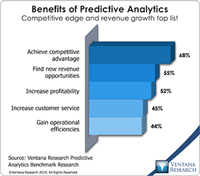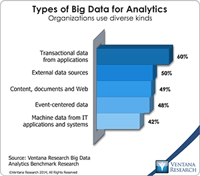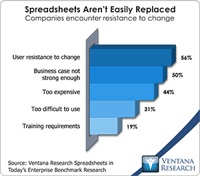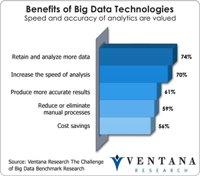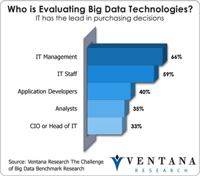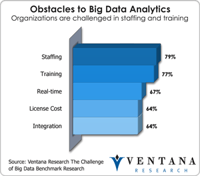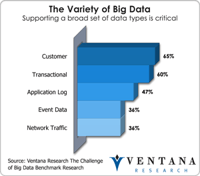Big data has become a big deal as the technology industry has invested tens of billions of dollars to create the next generation of databases and data processing. After the accompanying flood of new categories and marketing terminology from vendors, most in the IT community are now beginning to understand the potential of big data. Ventana Research thoroughly covered the evolving state of the big data and information optimization sector in 2014 and will continue this research in 2015 and...
Read More
Topics:
Big Data,
MapR,
Predictive Analytics,
Sales Performance,
SAP,
Supply Chain Performance,
Human Capital,
Marketing,
Mulesoft,
Paxata,
SnapLogic,
Splunk,
Customer Performance,
Operational Performance,
Business Analytics,
Business Intelligence,
Business Performance,
Cloud Computing,
Cloudera,
Financial Performance,
Hortonworks,
IBM,
Informatica,
Information Management,
Operational Intelligence,
Oracle,
Datawatch,
Dell Boomi,
Information Optimization,
Savi,
Sumo Logic,
Tamr,
Trifacta,
Strata+Hadoop
SAS Institute, a long-established provider analytics software, showed off its latest technology innovations and product road maps at its recent analyst conference. In a very competitive market, SAS is not standing still, and executives showed progress on the goals introduced at last year’s conference, which I covered. SAS’s Visual Analytics software, integrated with an in-memory analytics engine called LASR, remains the company’s flagship product in its modernized portfolio. CEO Jim Goodnight...
Read More
Topics:
Predictive Analytics,
IT Performance,
LASR,
Operational Performance,
Analytics,
Business Analytics,
Business Intelligence,
Business Performance,
Cloudera,
Customer & Contact Center,
Hortonworks,
IBM,
Information Applications,
SAS institute,
Strata+Hadoop
I had the pleasure of attending Cloudera’s recent analyst summit. Presenters reviewed the work the company has done since its founding six years ago and outlined its plans to use Hadoop to further empower big data technology to support what I call information optimization. Cloudera’s executive team has the co-founders of Hadoop who worked at Facebook, Oracle and Yahoo when they developed and used Hadoop. Last year they brought in CEO Tom Reilly, who led successful organizations at ArcSight, HP...
Read More
Topics:
Big Data,
Teradata,
Zoomdata,
IT Performance,
Business Intelligence,
Cloudera,
Hortonworks,
IBM,
Information Applications,
Information Management,
Location Intelligence,
Operational Intelligence,
Oracle,
Hive,
Impala,
Strata+Hadoop
In the realm of technology that matters for business and IT, our firm as part of our responsibility continually assesses the latest technology and how it can impact organizations’ efficiency and effectiveness. Our benchmark research in technology innovation found that 87% of participants indicated the importance of increasing the organization’s value through technology innovation. Every year we take our knowledge from research and technology briefings to focus on our Technology Innovation Awards
Read More
Topics:
Big Data,
Datameer,
Mobile,
Sales,
Sales Performance,
Social Media,
Supply Chain Performance,
Sustainability,
Customer,
ESRI,
Globoforce,
GRC,
HCM,
Kronos,
Kyriba,
Location Analytics,
Marketing,
NetBase,
Office of Finance,
Overall Operational Leadership,
Peoplefluent,
Planview,
SQLstream,
VMWare,
VPI,
IT Analytics & Performance,
IT Performance,
Operational Performance,
Analytics,
Business Analytics,
Business Collaboration,
Business Intelligence,
Business Mobility,
Business Performance,
CIO,
Cloud Computing,
Collaboration,
Customer & Contact Center,
Financial Performance,
Governance, Risk & Compliance (GRC),
Hortonworks,
IBM,
Informatica,
Information Applications,
Information Builders,
Information Management,
Information Technology,
KXEN,
Location Intelligence,
Operational Intelligence,
Oracle,
Workforce Performance,
Contact Center,
Datawatch,
Financial Management,
Information Optimization,
Johnson Controls Panoptix,
Roambi,
Service & Supply Chain,
Upstream Works,
Vertex,
Xactly
Microsoft has been steadily pouring money into big data and business intelligence. The company of course owns the most widely used analytical tool in the world, Microsoft Excel, which our benchmark research into Spreadsheets in the Enterprise shows is not going away soon. User resistance (cited by 56% of participants) and lack of a business case (50%) are the most common reasons that spreadsheets are not being replaced in the enterprise. The challenge is ensuring the spreadsheets are not just...
Read More
Topics:
Big Data,
Microsoft,
Tableau,
IT Performance,
Microsoft Office,
Microsoft Powerpoint,
Operational Performance,
Business Analytics,
Business Intelligence,
Business Performance,
CIO,
Cloud Computing,
Customer & Contact Center,
Financial Performance,
Hortonworks,
Information Applications,
Location Intelligence,
Microsoft Excel,
azure,
HDinsights
The big-data landscape just got a little more interesting with the release of EMC’s Pivotal HD distribution of Hadoop. Pivotal HD takes Apache Hadoop and extends it with a data loader and command center capabilities to configure, deploy, monitor and manage Hadoop. Pivotal HD, from EMC’s Pivotal Labs division, integrates with Greenplum Database, a massively parallel processing (MPP) database from EMC’s Greenplum division, and uses HDFS as the storage technology. The combination should help sites...
Read More
Topics:
EMC,
MapR,
HAWQ,
HDFS,
Pivotal HD,
Business Analytics,
Business Intelligence,
Cloud Computing,
Cloudera,
Hortonworks,
Information Applications,
Information Management,
Location Intelligence,
Cirro,
Hive,
Tableau Software,
Strata+Hadoop
Business is starting to realize that taking advantage of big data is not just technically feasible but affordable by organizations of all sizes. However, as outlined in our agenda on big data and information optimization, the technology must be engineered to the information needs of business. HortonWorks has been steadily advancing its big data technology called Hadoop and contributing its developments back to the Apache Software Foundation for a range of projects. The company performs...
Read More
Topics:
Big Data,
Microsoft,
Talend,
Teradata,
Simba,
Business Analytics,
Cloud Computing,
Hortonworks,
Informatica,
Information Applications,
Information Management,
HDP,
Hive,
Tez,
Strata+Hadoop
LucidWorks addresses the growing volume of information now being stored in the enterprise and in big data with two products aimed at the enterprise with search technology. Though you may not be familiar with LucidWorks (previously known as Lucid Imagination), the company has for many years contributed to Apache Lucene, an open source search project, and commercialized and supported for it for business.
Read More
Topics:
Big Data,
MapR,
Sales Performance,
IT Performance,
Operational Performance,
Business Analytics,
Business Intelligence,
Business Performance,
Cloud Computing,
Cloudera,
Customer & Contact Center,
Hortonworks,
Information Applications,
Information Management,
Operational Intelligence,
Search,
Strata+Hadoop
At the recent Teradata’s annual Partners user conference, the company outlined its expanding role as a provider distributed information architecture technology. My colleague Tony Cosentino assessed Teradata’s business analytics and big data strategy, but there is more under the covers in regards to the company’s expanding role for big data and enterprise architectures. Over the last several decades Teradata has been known for providing enterprise data warehouse appliances, such as its unveiling...
Read More
Topics:
Big Data,
QlikView,
SAS,
alteryx,
IT Performance,
Business Analytics,
Hortonworks,
Information Management,
Location Intelligence,
Operational Intelligence,
Strata+Hadoop
As volumes of data grow in organizations, so do the number of deployments of Hadoop, and as Hadoop becomes widespread, more organizations demand data analysis, ease of use and visualization of large data sets. In our benchmark research on Hadoop, 88 percent of organizations said analyzing Hadoop data is important, and in our research on business analytics 89 percent said it is important to make it simpler to provide analytics and metrics to all users who need them. As my colleague Mark Smith...
Read More
Topics:
Big Data,
Datameer,
MapR,
Operational Performance,
Business Analytics,
Business Intelligence,
Business Performance,
Cloudera,
Customer & Contact Center,
Hortonworks,
IBM,
Information Applications,
Operational Intelligence,
Visualization,
Data Discovery,
Strata+Hadoop


